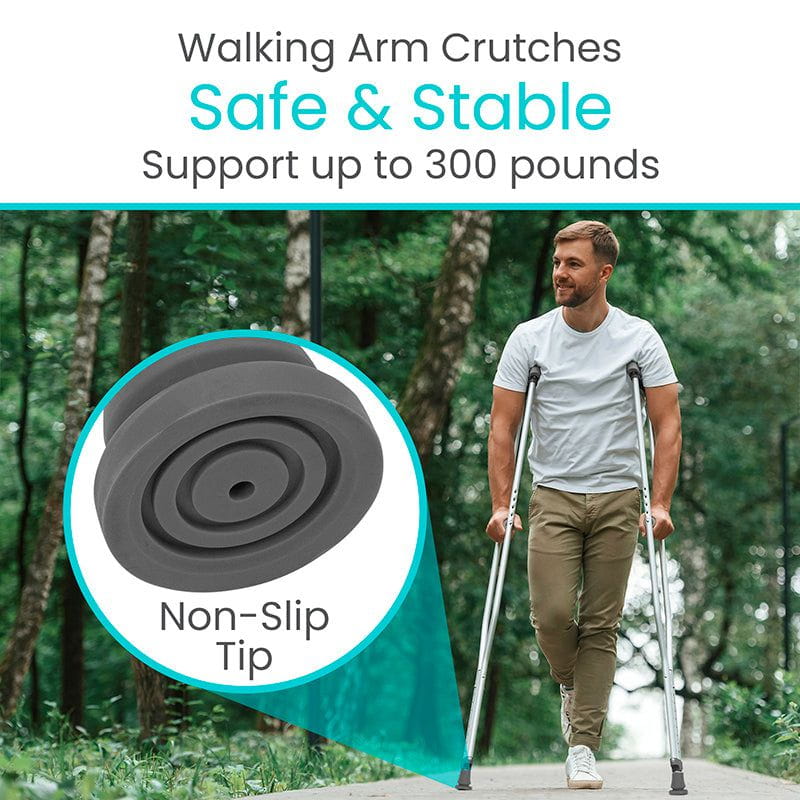Address
304 North Cardinal
St. Dorchester Center, MA 02124
Work Hours
Monday to Friday: 7AM - 7PM
Weekend: 10AM - 5PM
Address
304 North Cardinal
St. Dorchester Center, MA 02124
Work Hours
Monday to Friday: 7AM - 7PM
Weekend: 10AM - 5PM










Original price was: $49.99.$0.00Current price is: $0.00.
Crutches are one of the most widely used mobility aids in the world. Whether you’re recovering from an injury, surgery, or dealing with a temporary walking disability, crutches offer a simple, effective way to move around safely. Designed to reduce the weight placed on the lower limbs, crutches help people stay mobile and independent during recovery.
Available in various styles—from underarm (axillary) to forearm (elbow) and platform crutches—these tools support millions in regaining their mobility and confidence.
Ergonomic Hand Grips
Designed to reduce hand fatigue and improve grip comfort.
Adjustable Height
Most crutches allow height adjustment to suit different users.
Non-Slip Rubber Tips
Provide traction and prevent slipping on various surfaces.
Lightweight Materials
Typically made from aluminum or composite materials for easy handling.
Weight Distribution Design
Transfers weight from the legs to the upper body, easing pressure on injured limbs.
Cost-Effective
Crutches are generally affordable and widely available at pharmacies and medical stores.
Portable and Lightweight
They’re easy to carry, store, and transport—no need for batteries or charging.
Improved Mobility During Recovery
They allow people with foot, ankle, knee, or leg injuries to stay active and independent.
Different Styles for Different Needs
Underarm crutches for temporary support; forearm crutches for longer-term or neurological conditions.
Quick Setup and Use
No learning curve—most users can adjust and begin using crutches within minutes.
Underarm (Axillary) Crutches
Best for short-term use
Support under the armpits
Common after surgeries or minor leg injuries
Forearm (Lofstrand) Crutches
Ideal for long-term use
Feature cuffs around the forearm
Offer better mobility and are less bulky
Platform Crutches
Used for those who can’t grip with hands
Arm rests on a horizontal platform
| Feature | Details |
|---|---|
| Material | Aluminum, wood, or carbon fiber |
| Weight Capacity | 250 – 300+ lbs |
| Adjustable Height | Common for both adult & youth sizes |
| Weight | 2 – 5 lbs per crutch |
| Grip Type | Ergonomic, foam, or rubberized |
| Tip Material | Rubber (non-slip) |
Crutches remain a reliable and essential tool in the world of rehabilitation and mobility aids. Their simplicity, versatility, and accessibility make them ideal for people of all ages recovering from lower-body injuries. While they may require a bit of upper body strength and coordination, they offer a great balance between support and independence. Whether it’s a sprained ankle or post-operative care, crutches help you take your next steps—literally.
1. When should I use crutches?
When your doctor advises non-weight-bearing or partial-weight-bearing movement due to injury or surgery.
2. How do I choose the right size?
Your crutches should allow a 1–2 inch gap under your armpits and your elbows should be slightly bent while holding the grips.
3. Are crutches hard to use?
They may take some practice, but most people adjust quickly. A physical therapist can provide guidance if needed.
4. What’s the difference between forearm and underarm crutches?
Forearm crutches are better for long-term or neurological use, while underarm crutches are more common for short-term injuries.
5. Can children use crutches?
Yes, pediatric-sized crutches are available and adjustable to suit growing children.
6. How do I prevent underarm pain with crutches?
Keep your weight on your hands, not your armpits, and use padding if needed.
7. Are crutches safe on stairs?
Yes, but caution is essential. Use handrails and take it slow. Always lead with the good leg going up, and the injured leg going down.
8. Can I buy crutches online?
Absolutely. Many online medical retailers offer different sizes and types, often with customer reviews to help guide your choice.
9. How long will I need to use crutches?
It depends on your injury. Always follow your doctor’s advice and physical therapy plan.
10. What are alternatives to crutches?
Knee walkers, canes, walkers, or electric wheelchairs may be used depending on your condition and mobility needs.
Looking for the best Crutches? Explore our collection today and find the perfect fit for your needs!
| Size | Adult, Tall, Youth |
|---|
Reviews
There are no reviews yet.